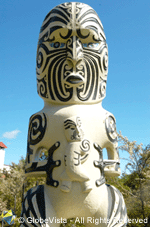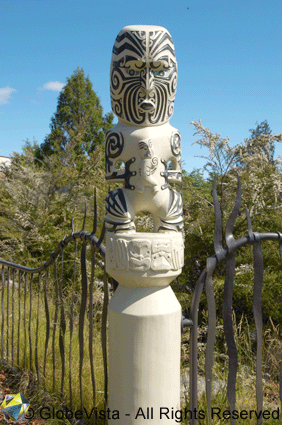Tunohopu sculpture

Public Art: Tunohopu sculpture
Sculptor: © Rakei Kingi
Date Unveiled: The Tunohopu sculpture was unveiled on the 30th of August 2007.
Description: A painted wooden carving depicting tribal chief Tunohopu clutching his much-loved son to his chest.
Location: This is one of two carvings guarding the Malfroy Geysers (the other being the Oruawhata sculpture) in Government Gardens, Rotorua, New Zealand.

So who was Tunohopu? : Tunohopu was a chief who lived on the shores of Lake Rotorua with his wives and children. One morning, before dawn, the Ngati-Tuwharetoa tribe from Taupo decided to raid their village. Tunohopu and his family sort shelter in a cave but in all the commotion he accidentally left his son Tai-operua behind. It was later discovered Tunohopu’s son had not been killed but kidnapped by Tamamutu, the leader of the war party. On hearing this, Tunohopu decided to find his son and bring him back home. He knew his tribe was no match against the Ngati-Tuwharetoa so instead set off to Taupo to face Tamamutu alone.
When he arrived he asked a small boy “Where is Tamamutu’s house?” then bravely walked through the enemy’s village straight to Tamamutu’s door.
Tamamutu was surprised and shocked at seeing Tunohopu standing there but marveled at his audacity and bravery. Even more so when Tunohopu told him he had traveled from Rotorua to retrieve his son or die in the attempt.
Tamamutu told the brave warrior that he would give back his son but only after he had been presented to the tribe. Tunohopu was given the finest of garments by Tamamutu to wear so he could look noble and chieftain-like in front his enemies and was then told to stand in the doorway of Tamamutu’s house with his spear in hand.
Tamamutu then walked to the village square and shouted at the top of his voice “He taua e! He taua e!” (“A war-party! A war-party !”). On hearing this all the men of the village grabbed their spears and clubs and ran to the perimeters of the village gates looking for the enemy invasion. Tamamutu then climbed onto the roof of his house and cried “He taua e! He taua kua uru ki to pa! Tenei e! Tenei kai roto i te whare!” (“A war-party! A war-party has entered the village! Here it is, here within the house!”).
The stunned warriors rushed to the chief’s house and saw their old enemy standing there, now a noble figure adorned in chiefly garb. Instead of killing Tunohopu where he stood, they realized he was standing in the shelter of the sacred threshold and was, in fact, their chief’s guest.
The tribespeople gathered around the house eager to hear the chief’s explanation. He told them of the brave Rotorua warrior’s solo journey, not with the intent for retribution or war but to simply find his son. At the end of the tale, the people of Taupo were ecstatic and in awe of his courage and determination. Tamamutu ordered Tunohopu’s son to be brought to the house where he was handed over to the now weeping warrior.
That night, during song and celebrations, the two chiefs made peace and declared an end to their fighting. Tunohopu would stay for many more days as an honored guest. On his return to Rotorua, he was accompanied by several Taupo tribes people who helped carry food and gifts for the people of Kawaha.